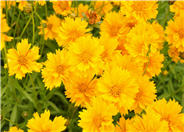
Common name:Double Sunburst Coreopsis/Tickseed
Botanical name:Coreopsis grandiflora 'Double Sunburst'
The "Double Sunburst' is a wonderful cultivar and a showy, southern U.S. native. Golden yellow double flowers on 36" tall bushy plants bloom from June to September in full sun and average to dry soils. It is wonderful in a dried flower arrangment. Pruning keeps the plants abundant with blooms. -Holland WIldflower Farm

Common name:Rosemary
Botanical name:Rosmarinus officinalis
Rosemary is hardy in full sun areas where winter temperatures do not drop below 10 degrees F. Rosemary is evergreen and makes a great aromatic hedge, 4'-6' tall and 2' wide. Foliage is used in cooking. Blue flowers appear in summer. This plant is drought tolerant once it's established. Bees love Rosemary!

Common name:Crape Myrtle
Botanical name:Lagerstroemia indica
The new leaves of this species are 2" long, bright green, and tinged with bronze. Some cultivars have spectacular fall color. When it has a bare outline, its rounded seed capsules add interest. Its delicate flowers bloom in 6"-12" long clusters. The flower colors could be shades of red, rose, pink, purple, and white, blooming in summer. It thrives on heat, and new cultivars have been created that resist mildew. This tree prefers full sun and has low watering needs once it's established.

Common name:Chinese Pistache
Botanical name:Pistacia chinensis
The Pistacia chinensis is a deciduous tree with broad, spreading growth to 50' in height. Its leaves have 10-16 leaflets, and the fall coloring arrives in beautiful shades of red, orange and yellow. Prune young trees to shape. This tree does not have edible nuts. Female trees have tiny red fruit, turning dark blue. It prefers full sun and deep, infrequent waterings. This is a great street or park tree.

Common name:Hybrid Tea Rose cultivar
Botanical name:Rosa Hybrid Tea selection
Hybrid tea roses are the traditional classic roses; buds are used for boutonnieres. These roses have long stems with a single rose at the end, which may or may not be fragrant. Blooms typically start in spring until fall. Many colors now available. Roses prefer full to part sun with well draining, rich soil. It needs fertilizer after each bloom period. It prefers medium watering and more in hot summer areas. Mulch well. Prune in winter. It usually grows 2'-6' tall.
| Designer: | Wow Factor |
Photographer: GardenSoft |
Soils and Compost:
Practice grass-cycling by leaving short grass clippings on lawns after mowing, so that nutrients and organic matter are returned to the soil.
Water Saving Tip:
Group plants in your garden according to their water needs (hydrozone).
Integrated Pest Management:
Develop healthy soil for plants that are vigorous and naturally pest-resistant.
